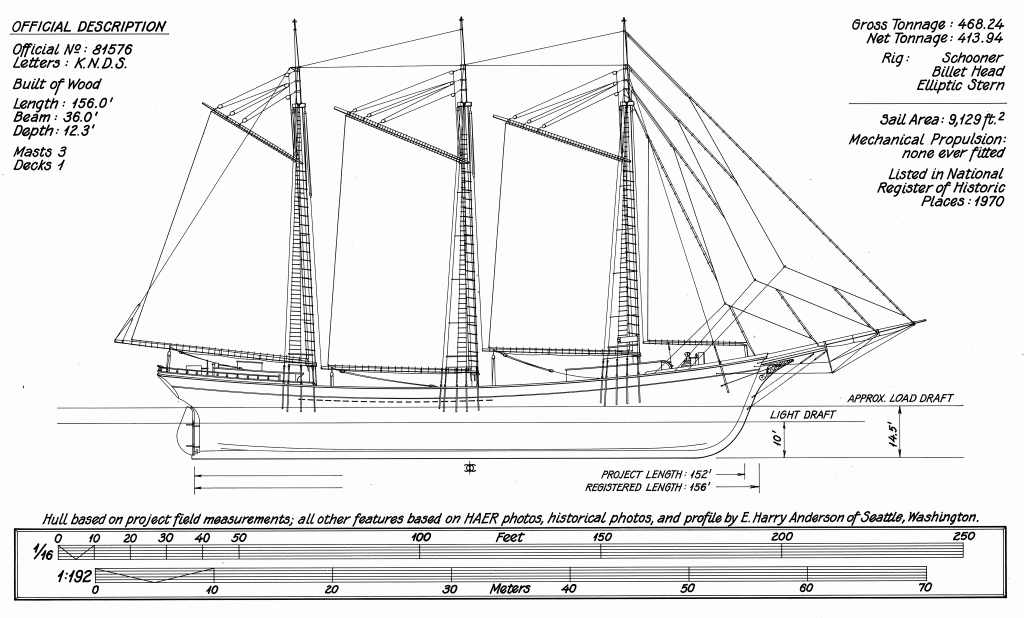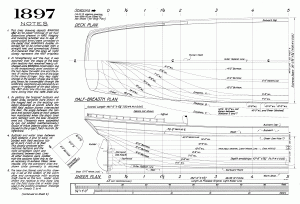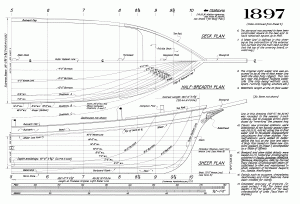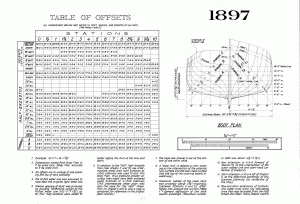Ship Modelers Can Recreate History
Plans for One of Two Remaining Lumber Schooners
Wooden Schooners Once Numbered in the Scores
See photographs on our Historic Lumber Schooner Wawona photo gallery.
From the scores of wooden three-masted schooners built in the 19th and early 20th centuries for service in the West Coast lumber trade, when these plans were drawn in 1986, Wawona was one of only two known to be preserved. She was dismantled in 2009. She and the single surviving lumber schooner, C.A. Thayer (National Maritime Museum, San Francisco), were built by Hans D. Bendixsen, who was well known in his time for the superior construction of his vessels.
Wawona was designed for the Dolbeer & Carson Lumber Company of Eureka, California to transport more than 500,000 board feet of lumber per voyage from from the Pacific Northwest to ports further south on the coast. Like most ships in her day, Wawona’s hull was lofted from a carved wooden half model rather than a detailed set of engineering drawings. She cost $29,075 to build, and was launched September 27, 1897.
Her official dimensions at launch were:
Length: 156.0 feet
Beam: 36.0 feet
Depth: 12.3 feet
Gross Tonnage: 468.42
Net Tonnage: 413.94
Wawona was listed on the National Register of Historic Places in 1970.
Like most vessels of her type, Wawona was designed with a large, unpartitioned hold. Ports in her stern permitted lumber to be loaded and unloaded quickly from below. Built with an exceptionally strong deck, more than half her load could be carried on deck. Her schooner rig was designed to be handled by a small crew (six to ten men) without interference from large cargoes on deck.
Where East Coast ships of the time were built primarily of oak, Wawona was reportedly built of Douglas fir, a species more plentiful than oak on the West Coast. In a 1986 survey, she still retained much of her original material: her bottom hull planking appeared to be original, and parts like the clamps – single pieces of timber about 145 feet long – were almost certainly original, since shipbuilding timbers of such length became rare and expensive early in the 20th century.
Upon the death of the owners of Dolbeer & Carson lumber company, Wawona was put up for sale. She was sold in January 1914 to Robinson Fisheries of Anacortes, Washington for $8,000. Robinson Fisheries converted Wawona for codfishing, adding New England fishing dories, three-tiered bunks below {to accomodate a much larger crew), and fresh water tanks, among other things.
During World War II, Wawona was conscripted by the U.S. Army for use as a lumber barge. When hostilities ceased, she was remasted and rigged, and returned to the fishing trade. Her final commercial voyage was in 1947. Though still in sound condition, the demand for codfish had not returned to its pre-war level, and trained crews and fishermen had become harder to find. With stiff competition from more efficient, powered modern vessels, the decision was made to take her out of service.
Wawona was laid up in Puget Sound harbor until 1953, when Montana cattle rancher, William P. Studdert, purchased her to transport cattle to the Soviet Union. While nothing ever came of this plan, Studdert held on to Wawona, anyway. In 1964, a group called “Save Our Ships,” forerunner to Northwest Seaport, Inc., purchased Wawona. She has served as a musuem exhibit ever since.
A very thorough, illustrated history titled “Pacific Schooner Wawona,” by Harriet Tracy DeLong was published in 1985 by Documentary Book Publishers Corporation of Bellevue, Washington.
The lines plans provided here were created in 1985 as part of a $2 million restoration project. They were recorded by the Historical American Engineering Record, a project of the National Park Service. The plans were delineated by Richard K. Anderson, Jr.




Where can a person get a set of building plans to build a model of the Wawona, for radio control?
Regards
Leonce
I don’t know of a set of plans for Wawona adapted for radio control, but you could certainly download the plans here and adapt them yourself. I would love to see the results!
Thanks for your reply to my question, you said I could download a set of plans here, where is here? I have looked all over the site and didn’t find the option to download, I am also going to build the Sibyl Marsten a West Coast steam powered lumber schooner or hooker for r/c . Any idea wher to find the plans will be greatly appreciated.
Regards
Leonce
If you left-click on the image of the plan you want, it opens up the full size image. Then right-click and choose “save image as” (or “save target as” depending on your browser) and choose a folder on your computer. That will download the full-size plan to your computer. Then you can put any plans you want printed onto a USB drive and take them to a copy store like Staples and they can print them out for you.
Thanks for your help.
Leonce
Hi jihitch
Ya, I tried this twice and all it gives is a blank page with a red cross in the upper left corner. Leonce
Hi, Doe’s anyone know why I can’t open the plan of Wawona after I left click to see it and download the plan? Is there a qlitch in the system, I really want these plans. Also is the Wawona open to public for barding to take pictures? Thanks
Leonce
I emailed you one of the plans in gif format. Let me know if you can open it on your computer.
Hi, Yes I recieved the pictures ok but I had my computer savy son change all the pictures to tiff as to down load them and was able to have a copying outfit print me the plans. I also found the C.A. Thayer plans more useful as they are more conplete. I also downloaded all pictures of both boats, I just wish someone had the foresight to take better pictures of the Wawonas fore cabin and focsle and showed where the capstan was originally placed. Well anyhow I have enough to build the boat in 1/32 scale for r/c.
[…] the growing cities of California. Two of them were all that remained of this vast fleet when these free ship plans of the lumber schooner Wawona were drawn. Built in the 1897 for Dolbeer & Carson Lumber […]
[…] Historic lumber schooner Wawona […]